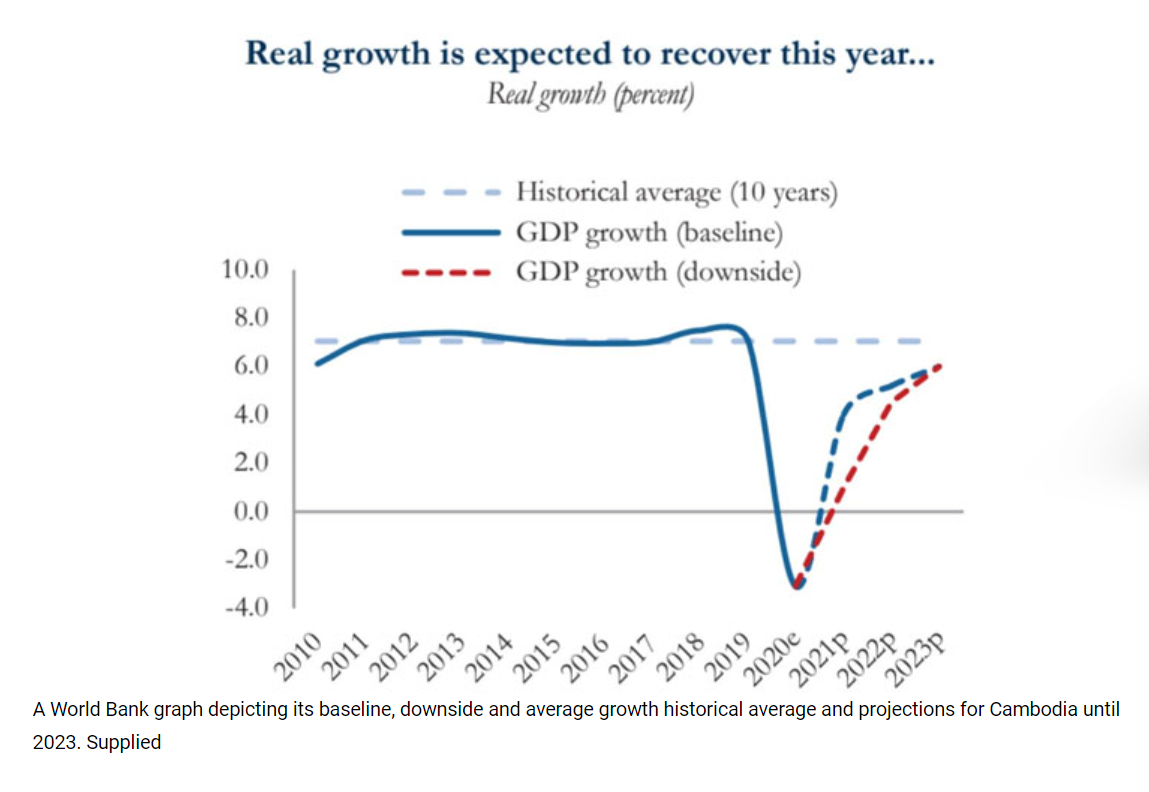Cambodia: World Bank’s 4.1 percent growth projection holds but recovery deemed vulnerable
The World Bank yesterday maintained its 4.1 percent growth projection for the Kingdom in its first economic update for Cambodia of the year.
The global financial institution, which aids development by providing loans and grants to countries, said that the Kingdom’s agriculture segment “remained resilient” while the tourism sector had been “hit hard” and the manufacturing sector “has gradually adapted to changing external conditions”.
Despite having largely escaped the health implications created by the pandemic last year, the Cambodian economy was hit hard with the World Bank (WB) reporting a contraction of 3.1 percent in 2020.
“Like many countries in the region, Cambodia has been hit hard by the global demand shock brought on by Covid-19. But the good news is that Cambodia has now vaccinated more than three million people, one of the highest rates in the region,” WB Country Manager, Iguna Dobraja, said in a statement.
The WB noted that the Kingdom’s growth outlook “remains highly uncertain” with recovery underpinned on vaccination efforts. It warned that sluggish vaccination and prolonged lockdowns could slow economic growth to just 1 percent this year.
“The projections assume that market confidence is restored, while the current community outbreaks, which began in February 2021, remain under control, resulting in a staged easing of the lockdown restrictions without significant mid- to long-term adverse impacts on the corporate or banking sector,” said the WB report titled Road to Recovery: Special Focus Government-to-Person Payments for Social Benefits.
The WB projects real growth to reach 5.2 percent in 2022 under current conditions. If the pandemic is not managed well, the country is forecast to see growth of 4.5 percent.
“Under the baseline, it is expected that the authorities are taking steps to attract further [foreign direct investment] and promote trade by introducing a new investment law in the second half of 2021, boosted by recently signed free trade agreements,” the study added.
The report credited the Cambodia-China Free Trade Agreement (CCFTA) for increasing demand in the agriculture sector.
The Ministry of Commerce reported last month that bilateral trade volume from January to April with China increased by 19.7 percent over the same period last year, with exports to the mainland reaching approximately $424 million – up 16.7 percent.
“The opportunity given by Chinese market will help to promote a larger trade volume and strengthen a stronger relationship between the two countries under the recently-signed Cambodia-China Free Trade Agreement,” Penn Sovicheat, Ministry of Commerce undersecretary of state told Xinhua.
It also noted that the cash transfer scheme to benefit financially vulnerable families amid the pandemic had seen increased demand. Direct financial aid reached 710,000 households, the equivalent of 19.5 percent of families as of January.
Khmer Times previously reported that the government had contributed more than $335 million through its Covid-19 Cash Transfer Programme. The initiative is up for renewal next week and is anticipated to be renewed for another three months, according to sources familiar with the matter.
The budget for pandemic-related relief this year is $719 million, down from $823 million last year.
The WB estimated that the Kingdom’s fiscal deficit widened to approximately 2.7 percent of gross domestic product last year.
Spurred by what is dubbed “the great reopening” in the US – Cambodia’s largest trading partner – the export of goods grew by 12.2 percent during the first four months of the year, according to the WB.
The share of garment exports in terms of total goods, excluding gold, fell by 45.6 percent, the study found.
Ken Loo, secretary-general for the Garment Manufacturers Association in Cambodia, told Khmer Times that a decline in garment exports relative to total exports was to be expected since the Kingdom was diversifying beyond its traditional pillars of industries under the Industrial Development Policy 2015-2025.
“The Kingdom is growing and as we move forward, manufacturing will likely expand beyond garments, so it is important that we remain competitive in the global marketplace. I anticipated a strong rebound for the garment, footwear and travel bag market in 2021 because overseas orders have increased since the new year. I credit government efforts to vaccinate factory workers for the industry’s ability to meet demand,” he said.
Source: https://www.khmertimeskh.com/50876657/world-banks-4-1-percent-growth-projection-holds-but-recovery-deemed-vulnerable/


 English
English




